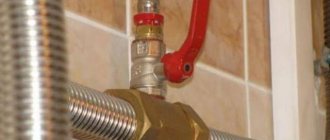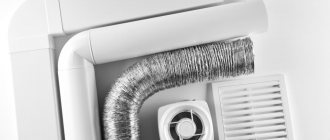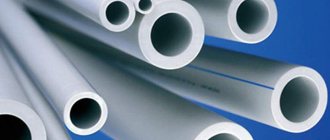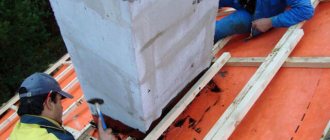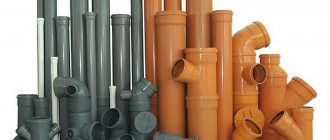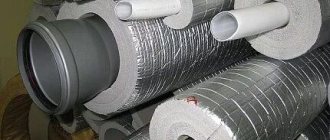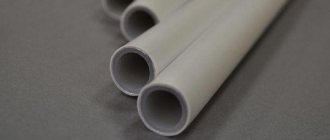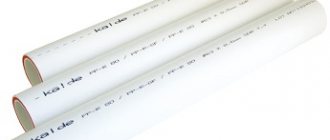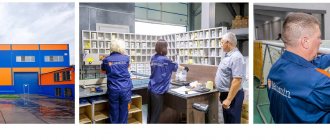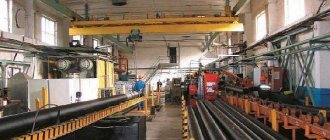In 9 out of 10 cases, plastic (polymer) pipes are used to install a new sewer system or replace an old one. There are many reasons for this - reliability and durability, ease of installation, low cost and much more. Today the market is filled with such products from many manufacturers and it is quite difficult for the average user to make a choice.
One of the most popular brands of polymer sewer pipes is Pragma. We can say that these pipes are the ancestors of corrugated sewerage. The products of this brand are intended for those who primarily look at quality rather than cost. Since in conditions of fierce competition the company pays great attention to quality, this accordingly affects the cost.
Peculiarities
Pragma are sewer polypropylene pipes with two walls. The inner wall is smooth, gray in color, and the outer wall has a corrugated structure and orange (red) color.
They are often used in the construction of gravity (free-flow) or storm sewer systems, as well as drainage systems. An ideal option for draining wastewater from industrial buildings. Withstands exposure to chemical and other aggressive environments. They are not subject to rotting or clogging, and are resistant to any type of deformation.
Scope of use of Pragma pipes
Pragma pipes for external sewerage
Area of application of the elements:
- household needs;
- drainage of surface water flows;
- removal of industrial waste;
- soil drainage;
- arrangement of agricultural cleaning networks.
With their help, they organize channels for wastewater in highway embankments, port terminals and airports. Most often, the elements are used when constructing a gravity sewer network or storm drain, as well as drainage systems.
Characteristics
Products are produced in lengths of 6 meters, the diameter can be from 150 to 1137 mm. The two-layer structure (the top layer is corrugated, the inner layer is smooth) is manufactured simultaneously, which guarantees strength.
On one side of the pipe there is a socket hermetically welded, and on the other there is a groove with a rubber seal. Main technical characteristics:
- manufacturing material – polypropylene;
- operating temperature – from −25° to +70° C;
- connection method - in a socket;
- hardness level – 8 – 16 kN/m²;
- Maximum laying depth is up to 10 m.
Using various fittings, the Pragma pipe can be joined to pipes made of any materials.
Cost of Pragma fittings
| Name | vendor code | Outer diameter, mm | Inner diameter, mm | Price per piece, m/rub. |
| Double bell | 92163454 | 160 | 1 782 | |
| Double bell | 92203454 | 200 | 2 263 | |
| Double bell | 92313454 | 315 | 3 213 | |
| Repair coupling | 25300200 | 200 | 2 263 | |
| Repair coupling | 23603300 | 343 | 3 213 | |
| Repair coupling | 23603600 | 688 | 6 913 | |
| Ring sealing | 95016700 | 160 | 57 | |
| Ring sealing | 95020700 | 200 | 98 | |
| Ring sealing | 95040700 | 400 | 451 | |
| Ring sealing | 95060720 | 600 | 1 129 |
All PragmaPipe pipes are manufactured in accordance with Russian GOST TU 2248−001−96467180−2008 and European standards for free-flow pipes EN -13476.
Advantages
Due to the use of high-quality materials and modern manufacturing technology, the products have a number of advantages over similar products. Here are just some of them:
- chemical resistance – can be used for both wastewater and chemical disposal;
- withstand temperature changes from -20°C to +90°C;
- hardness class – SN8;
- light weight, telescoping capability;
- simple installation;
- service life ≈ 100 years;
- durable, resistant to shock and deformation;
- practically not subject to clogging.
Application area
Products of this type are intended for the installation of non-pressure underground sewerage systems for the following applications:
- household;
- rainwater drainage;
- removal of industrial waste;
- soil drainage;
- livestock and agricultural systems;
- arrangement of passages for water in embankments of highways.
Product Features
Polypropylene PP pipes from “Pragma” have a number of attractive properties that significantly expand the scope of application of this product.
Pragma pipes are resistant to high temperatures, aggressive environments and mechanical damage
Resistant to high temperatures. The usual temperature of wastewater is no more than 35-40ºC, and Pragma products are designed to work with a medium whose temperature can reach 60ºC (short-term exposure to 95ºC is allowed).
Resistance to low temperatures. Pragma sewer pipes can withstand up to one hundred freeze-thaw cycles without loss of physical properties. Polypropylene products tolerate low temperatures well, and installation of systems using them is possible at 10 degrees below zero without preheating in closed, insulated rooms.
Resistance to mechanical damage (impact resistance). Pragma corrugated pipes, due to their high impact strength, easily withstand shocks and falls during transportation or installation. In addition, the additional rigidity obtained from the wavy outer surface allows it to withstand significant loads of direct contact with the ground.
Corrugated pipes are resistant to deformation
When wastewater passes through a sewer, it always carries with it solid particles, such as sand. The impact of foreign objects on the inner surface leads to its wear over time.
In addition, having minor damage (scratches), the inside begins to become overgrown with deposits, which ultimately leads to the need for repair or cleaning.
Polypropylene PP pipes “Pragma” do not have a specific wear period, since the thickness of their walls is designed for the entire service life, and the material of manufacture is not susceptible to external influence.
Since the Pragma corrugated polymer sewer pipe has an exceptionally smooth inner surface (unlike cast iron or asbestos-cement pipes), even at low flow speeds, from 0.4 m/s, no deposits occur on its walls. This feature significantly reduces the cost of sewer cleaning.
Corrugated sewer pipes have a long service life
Polypropylene is a dielectric. Therefore, when laying systems from Pragma products, there is no need for additional costs for equipment to protect against stray currents that can pass in the ground.
Installation
Pragma pipes are joined in several stages:
- Clean the end of the pipe and the socket from dirt.
- Place a rubber seal on the corrugated part.
- Lubricate the seal and socket with soapy water.
- Insert the end of the pipe into the socket.
The procedure for connecting to HDPE or PVC pipes is similar, the only difference is that you need to use an adapter. If you need to cut off a piece of pipe, the cut is made along the groove of the corrugation, then the surface is cleaned of dust and burrs; chamfering is not required.
How to understand the marking of polymer pipes?
In order to facilitate the selection and identification of pipe products, sewer pipes are marked. A certain set of information about the product is applied by laser printing to the outer surface of the pipe. The inscriptions are located along the entire length of the pipe at intervals of 1 meter. The labeling indicates:
- Trademark or name of the manufacturer.
- Product symbols.
- Date of manufacture.
- Batch or line number.
What is included in the concept of “pipe symbols”? These are the main characteristics of this type of pipe. The manufacturer indicates:
- The brand of polymer from which the pipes are made.
- SDR.
- Nominal dimensions (diameter) of the product.
- Pipe wall thickness.
- Purpose of the product (for transporting technical media or drinking water).
- GOST or TU according to which the pipe was manufactured.
Advice! The ability to read labels greatly facilitates the choice of products, since they contain all the necessary information about the product.
What is SDR?
If most of the markings do not raise questions, then the abbreviation SDR may raise doubts. It turns out that this abbreviation characterizes the size of the pipe - the ratio of the outer nominal diameter to the nominal thickness of the pipe. It is clear that the higher the SDR, the thinner the pipe is. Conversely, thick-walled products have a very low SDR.
An example of decoding the designation
For example, the pipe walls are marked “PE 80 SDR7.4 – 90×12.3 technical GOST 18599-01”. The decoding of the marking will look like this: “a pipe made of polyethylene grade PE80 in accordance with GOST 18599-01, the pipe diameter is 90 mm, its wall thickness is 12.3 mm.
So, for the installation of sewerage systems, it is better to choose pipes and pipeline fittings produced by well-known manufacturers. Such products undergo strict quality control, so the assembled pipelines will be durable and reliable.
Connecting Korsis pipes to each other
The Korsis connection is possible using several methods:
- using a polyethylene coupling;
- butt welding;
- socket connection.
With PE coupling
The coupling method of connection is the most common. Requires the use of an O-ring. For pipes with a diameter of less than 200 mm, the ring is inserted into the second wave of corrugation. For products over 200 mm - first. The position of the sealing tongue is towards the nearest end of the pipe. This ensures a perfect fit of the coupling and guarantees a tight connection.
The surfaces to be joined must be cleaned of dirt and lubricated with a silicone water-repellent compound. At the same time, the lubricant used in the winter season differs from the summer version.
Butt welding
Butt soldering of Korsis products is carried out in a standard manner using hydraulic welding machines. The elements to be welded are clamped by electric drives, the soldering planes are aligned with a facing tool, which are then melted by a heating element. After which automatic connection and fixation occurs. Modern equipment allows soldering of polymer pipes up to 1200 mm in size with minimal human intervention.
It should be noted that this method of connecting Korsis products is rarely used. Welding machines for soldering pipes of such large sizes are expensive and heavy to transport. For ease of installation, the manufacturer offers fastening elements - couplings, rings. Products of large sizes (over 250 mm) are equipped with a socket.
Socket connection
This method is used to connect large-sized products. The manufacturer supplies pipes larger than 25 cm in diameter with an already welded socket. For installation, an O-ring and water-repellent silicone-based lubricant are used.
Price for HDPE pipes grade PE-100
| vendor code | Diameter, mm | Wall thickness, mm | Unit | Price per linear meter/rub. |
| 0401170034P | 32 | 3,6 | bay 200 m | 39,04 |
| 0401171041P | 40 | 4,5 | bay 100−200 m | 60,84 |
| 0401210064P | 90 | 10,1 | bays 100−200 m | 304,80 |
| 0402260160P | 160 | 17,9 | 12 m sections | 876,70 |
| 0402260400P | 400 | 44,7 | 12 m sections | 5 467 |
| 0402260560P | 560 | 62,5 | 12 m sections | 10 703 |
| 0402260630P | 630 | 70,3 | 12 m sections | 13 530 |
Assembly nuances
The characteristics of these products make it possible to lay drainage pipes at depths of up to 15 meters underground. At the same time, they cannot be deepened by less than 1 meter.
When backfilling a trench after laying Korsis sewer pipes, you should correctly select the type of backfill material. The fraction of its granules must be selected so that it can be freely placed between the waves of the pipe corrugation without damaging it.
Thus, both types of pipes described above are optimally suited for laying a pipeline for sewage and transporting industrial wastewater. They can be successfully used by both small contractors and large industrial enterprises.
Dimensions of Pragma and Korsis products
Products produced under the Pragma and Korsis trademarks are delivered to the consumer in the form of six or twelve meter lengths. Moreover, the latter option is preferable from the point of view of pipeline reliability and installation speed.
The diameter of these pipes ranges from 110 to 1200 millimeters. The actual wall thickness, excluding the height of the corrugation crest, ranges from one to five millimeters. In addition, there is a special, industrial series of pipes of this type with a diameter of two meters.
Speaking of sizes, it should be noted that all pipes with a diameter greater than 10 inches and a quarter (from 315 millimeters) are supplied paired with integrated sockets. This makes installation easier.
Who produces?
The manufacturer of Pragma pipes is the Austrian concern PipeLife.
It is a world leader in the production of pipelines made from modern, reliable polymers.
Head offices and representative offices are open in 27 countries.
These also include Russia and Ukraine.
Production facilities are currently located in all of these countries.
This large international concern supplies products to more than 70 countries.
The range of Pragma pipes includes their various modifications:
- DN/OD 160-800 mm outer Ø.
- DN/ID 200-1000 mm internal Ø.
Including:
- PRAGMA red. TU 2005;
- PRAGMA SN-8. TU 2006;
- PRAGMA SN-8 SUPER PLAST. TU 2007;
- PRAGMA-POLITRON K2KAN.TU 2005;
- PRAGMA-POLITRON PRO KAN. TU 2005;
- PRAGMA X-STREAM WAVIN (black). TU 2007.
Typical Pragma® Pipe Sizes
| DN | Int. diameter, di, mm | Ext. diameter, de, mm | External diameter of the socket, dy, mm | Socket length, t mm | Total length of the socket, L1, mm | Weight of 1m of pipe, kg SN 8 | Weight of 1m of pipe, kg SN 10 | Weight of 1 m of pipe, kg SN 16 |
| ID 150 | 150 | 170 | 1,44 | |||||
| ID 200 | 197 | 228 | 248 | 102 | 170 | 1,8 | 2,21 | 2,39 |
| ID 250 | 248 | 285 | 308 | 108 | 185 | 3,1 | 3,48 | 4,12 |
| ID 300 | 300 | 343 | 374 | 102 | 185 | 4,7 | 4,7 | 6,25 |
| ID 400 | 400 | 458 | 498 | 122 | 226 | 7,8 | 8,45 | 10,4 |
| ID 500 | 500 | 573 | 624 | 149 | 284 | 12,5 | 12,58 | 16,6 |
| ID 600 | 600 | 688 | 750 | 172 | 400 | 18,4 | 18,8 | 24,5 |
| ID 800 | 803 | 925 | 1003 | 214 | 421 | 34 | 36 | 45,2 |
| ID 1000 | 1 000 | 1140 | 1222 | 291 | 546 | 50 | 55 | 66,5 |
| OD 160 | 139 | 160 | 184 | 75 | 140 | 1,2 | 1,3 | 1,57 |
| OD 200 | 175 | 200 | 227 | 92 | 162 | 1,88 | 1,95 | 2,5 |
| OD 250 | 220 | 250 | 284 | 103 | 185 | 3,24 | 3 | 4,31 |
| OD 315 | 277 | 315 | 356 | 120 | 211 | 4,67 | 4,3 | 6,2 |
| OD 400 | 350 | 400 | 451 | 116 | 231 | 6,99 | 7 | 9,47 |
| OD 500 | 436 | 500 | 556 | 136 | 302 | 10,8 | 10 | 14,3 |
| OD 630 | 549 | 630 | 712 | 167 | 373 | 16,5 | 15,62 | 21,9 |
The manufacturer may make changes without notice to improve product characteristics.
The maximum short-term temperature of the transported medium is 90 *C.
When designing sewer systems, paramount importance is usually given to issues of final cost (which is understood as the total cost of material, installation and operation) and durability, subject to proper maintenance of such complex engineering structures.
The project developer, customer, contractor and operation service must optimize all aspects and components of the system: route layout, choice of material, determination of installation methods and technology, operating mode.
Summary description of corrugated pipes for sewerage and drainage from various manufacturers.
Technical description
Pragma pipes are a corrugated polymer pipe. Thanks to the cast double-wall design, in which the outer wall is corrugated and the inner wall is smooth, pipes and fittings can be used for laying sewer networks for sanitary, storm and general purposes under roads and other, including heavily loaded surfaces.
Pragma pipe from the Pipelife company is produced in the OD/DN and ID/DN using double coextrusion technology in the form of double-walled corrugated pipes with ring stiffness SN8, SN10 and SN16.
Pipes for external sewerage Pragma (Pipelife) have been on the market since the late 90s and have been promoted since 2003 by the well-known brand Pragma . The actual production at that time was located in Austria. In 2000, a representative office of the Pipelife concern was opened in Russia. In 2007, a plant for the production of Pragma pipes was opened in the Kaluga region in the city of Zhukov. In 2008, the Rospipe company ceased to exist. In parallel with this, in 2009, the production of corrugated pipes under the Pragma . The pipes were produced using a similar technology, but with a seamless socket, which made it quite fragile and yellow fiberglass tape was used for strengthening. After a series of court decisions, the Pipelife concern challenged the right to use the Pragma trademark by FTK-Rostr. And the latter had to change it to her own - “ Rostr ”. The plant was closed in 2015. Currently, Pragma pipes are produced only by the Pipelife concern.
Pragma pipes are identical in their main characteristics to pipes from Ikaplast, ProKan, Corex and a number of other foreign and Russian manufacturers of corrugated pipes .

